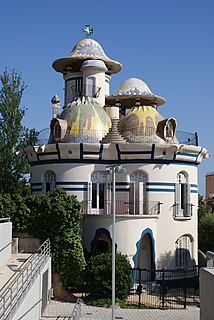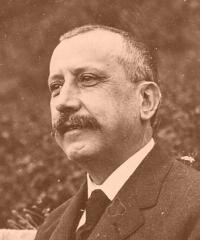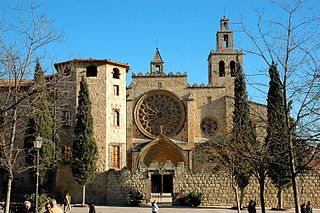
Tarragona is a port city located in northeast Spain on the Costa Daurada by the Mediterranean Sea. Founded before the 5th century BC, it is the capital of the Province of Tarragona, and part of Tarragonès and Catalonia. Geographically, it is bordered on the north by the Province of Barcelona and the Province of Lleida. The city has a population of 201,199 (2014).
Terrassa is a city in the east central region of Catalonia, Spain, in the province of Barcelona, comarca of Vallès Occidental, of which it is the co-capital along with Sabadell.

Mataró is the capital and largest town of the comarca of the Maresme, in the province of Barcelona, Catalonia Autonomous Community, Spain. It is located on the Costa del Maresme, to the south of Costa Brava, between Cabrera de Mar and Sant Andreu de Llavaneres, 30 kilometres north-east of Barcelona. As of 2010, it had a population of c. 122,932 inhabitants.

Vic is the capital of the comarca of Osona, in the province of Barcelona, Catalonia, Spain. Vic is located 69 km (43 mi) from Barcelona and 60 km (37 mi) from Girona.

The Cathedral of the Holy Cross and Saint Eulalia, also known as Barcelona Cathedral, is the Gothic cathedral and seat of the Archbishop of Barcelona, Catalonia, Spain. The cathedral was constructed from the thirteenth to fifteenth centuries, with the principal work done in the fourteenth century. The cloister, which encloses the Well of the Geese, was completed in 1448. In the late nineteenth century, the neo-Gothic façade was constructed over the nondescript exterior that was common to Catalan churches. The roof is notable for its gargoyles, featuring a wide range of animals, both domestic and mythical.

The Trambaix is one of Barcelona's three tram systems. It is operated by TRAMMET connecting the Baix Llobregat area with the city of Barcelona, Catalonia, Spain. It opened to the public on 5 April 2004 after a weekend when the tram could be used free of charge.

Sant Just Desvern is a town near Barcelona, in the comarca of the Baix Llobregat, Catalonia, Spain.

Sant Joan Despí is a city and municipality located in the Baix Llobregat area. It is situated on the left bank of the Llobregat river. Es is a dialectal form of the masculine article el, hence Despí would be rendered Del pi in standard Catalan.

Sant Feliu de Llobregat is an industrial city and municipality in Catalonia, Spain, in the province of Barcelona. It is the capital of the comarca of Baix Llobregat, and the see of a bishopric since June 2005.

Sant Feliu de Guíxols or San Felíu de Guíxols in Spanish is a municipality in the comarca of the Baix Empordà in Catalonia, Spain. It is situated on the Costa Brava and is an important port and tourist centre. The district abuts to the north, the upmarket s'Agaró resort built round the Sant Pol Beach. In addition to tourism and the port the cork industry is a traditionally local industry. The town contains a large monastery which now houses the town museum and is a protected historico-artistic monument. The C-253 road runs north along the coast to Platja d'Aro and Palamós, while the C-65 road runs inland from the town. The GI-682 provides a dramatic cliff top drive to Tossa de Mar to the south.

The Roman Catholic Diocese of Sant Feliu de Llobregat is a diocese located in the city of Sant Feliu de Llobregat in the Ecclesiastical province of Barcelona in Spain.

Rail transport in Catalonia operates on three rail gauges and services are operated by a variety of public operators:

Joan Rubió y Bellver was a Spanish architect famous for his contributions to the Catalan Modernista movement.

The Cathedral of Tarragona is a Roman Catholic church in Tarragona, Catalonia, Spain. The edifice is located in a site previously occupied by a Roman temple dating to the time of Tiberius, a Visigothic cathedral, and a Moorish mosque. It was declared a national monument in 1905.

The Monastery of Sant Cugat is a Benedictine abbey in Sant Cugat del Vallès, Catalonia, Spain. Founded in the ninth century, and under construction until the 14th century, it was the most important monastery in the county of Barcelona. Its most notable architectural feature is its large Romanesque cloister.

Catalunya en Miniatura is miniature park inaugurated in 1983 in Torrelles de Llobregat, 17 km from Barcelona. The park is 60,000 square meters, 35,000 of them devoted to the scale models, it is one of the largest miniature parks in the world, and the largest of the 14 miniature building exhibitions present in Europe. It displays 147 models of palaces, churches, bridges and other buildings from Catalonia and Mallorca and it includes all the major works by the renowned architect Antoni Gaudí.

Sant Feliu de Llobregat Cathedral or the Cathedral of Saint Lawrence is a Roman Catholic cathedral in Sant Feliu de Llobregat, Catalonia, Spain. It is the seat of the Diocese of Sant Feliu de Llobregat.

Historically, the city of Barcelona, in the Spanish autonomous community of Catalonia, had a large tramway network. The city's first tram line opened in 1872, but almost all of these historic lines had closed by 1971, being replaced by buses and by the expanding Barcelona Metro. The one remaining line, the Tramvia Blau, was retained as tourist attraction, utilising historic rolling stock. However at the beginning of the 21st century, two new tram systems, the Trambaix and Trambesòs, opened in the suburbs of the city.
In the run up to the 2015 Spanish local elections, various organisations carried out opinion polling to gauge voting intention in local entities in Spain. Results of such polls for municipalities in Catalonia are displayed in this article. The date range for these opinion polls is from the previous local elections, held on 22 May 2011, to the day the next elections were held, on 24 May 2015.






















